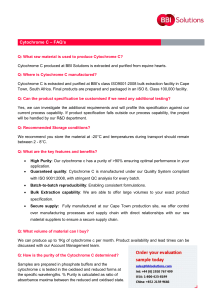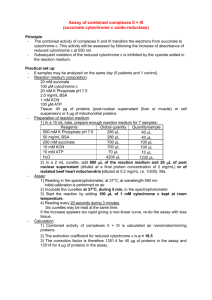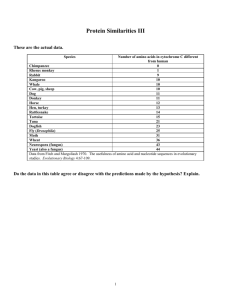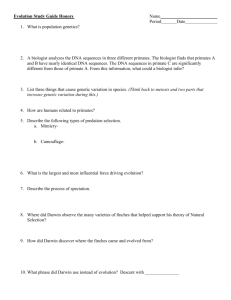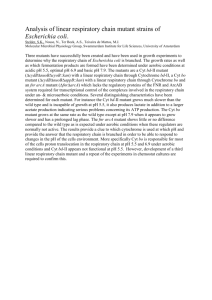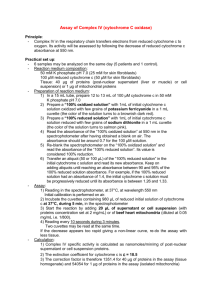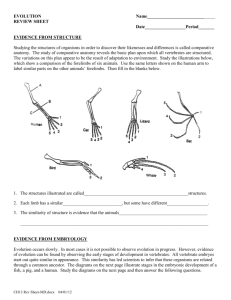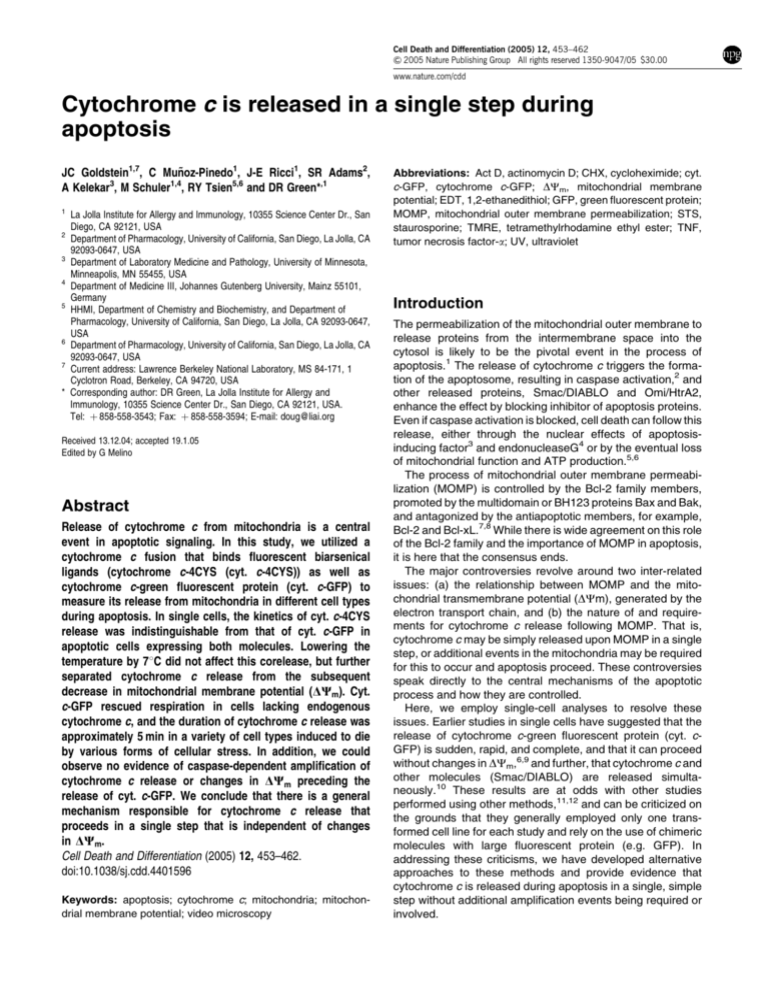
Cell Death and Differentiation (2005) 12, 453–462
& 2005 Nature Publishing Group All rights reserved 1350-9047/05 $30.00
www.nature.com/cdd
Cytochrome c is released in a single step during
apoptosis
JC Goldstein1,7, C Muñoz-Pinedo1, J-E Ricci1, SR Adams2,
A Kelekar3, M Schuler1,4, RY Tsien5,6 and DR Green*,1
1
La Jolla Institute for Allergy and Immunology, 10355 Science Center Dr., San
Diego, CA 92121, USA
2
Department of Pharmacology, University of California, San Diego, La Jolla, CA
92093-0647, USA
3
Department of Laboratory Medicine and Pathology, University of Minnesota,
Minneapolis, MN 55455, USA
4
Department of Medicine III, Johannes Gutenberg University, Mainz 55101,
Germany
5
HHMI, Department of Chemistry and Biochemistry, and Department of
Pharmacology, University of California, San Diego, La Jolla, CA 92093-0647,
USA
6
Department of Pharmacology, University of California, San Diego, La Jolla, CA
92093-0647, USA
7
Current address: Lawrence Berkeley National Laboratory, MS 84-171, 1
Cyclotron Road, Berkeley, CA 94720, USA
* Corresponding author: DR Green, La Jolla Institute for Allergy and
Immunology, 10355 Science Center Dr., San Diego, CA 92121, USA.
Tel: þ 858-558-3543; Fax: þ 858-558-3594; E-mail: doug@liai.org
Received 13.12.04; accepted 19.1.05
Edited by G Melino
Abstract
Release of cytochrome c from mitochondria is a central
event in apoptotic signaling. In this study, we utilized a
cytochrome c fusion that binds fluorescent biarsenical
ligands (cytochrome c-4CYS (cyt. c-4CYS)) as well as
cytochrome c-green fluorescent protein (cyt. c-GFP) to
measure its release from mitochondria in different cell types
during apoptosis. In single cells, the kinetics of cyt. c-4CYS
release was indistinguishable from that of cyt. c-GFP in
apoptotic cells expressing both molecules. Lowering the
temperature by 71C did not affect this corelease, but further
separated cytochrome c release from the subsequent
decrease in mitochondrial membrane potential (DWm). Cyt.
c-GFP rescued respiration in cells lacking endogenous
cytochrome c, and the duration of cytochrome c release was
approximately 5 min in a variety of cell types induced to die
by various forms of cellular stress. In addition, we could
observe no evidence of caspase-dependent amplification of
cytochrome c release or changes in DWm preceding the
release of cyt. c-GFP. We conclude that there is a general
mechanism responsible for cytochrome c release that
proceeds in a single step that is independent of changes
in DWm.
Cell Death and Differentiation (2005) 12, 453–462.
doi:10.1038/sj.cdd.4401596
Keywords: apoptosis; cytochrome c; mitochondria; mitochondrial membrane potential; video microscopy
Abbreviations: Act D, actinomycin D; CHX, cycloheximide; cyt.
c-GFP, cytochrome c-GFP; DCm, mitochondrial membrane
potential; EDT, 1,2-ethanedithiol; GFP, green fluorescent protein;
MOMP, mitochondrial outer membrane permeabilization; STS,
staurosporine; TMRE, tetramethylrhodamine ethyl ester; TNF,
tumor necrosis factor-a; UV, ultraviolet
Introduction
The permeabilization of the mitochondrial outer membrane to
release proteins from the intermembrane space into the
cytosol is likely to be the pivotal event in the process of
apoptosis.1 The release of cytochrome c triggers the formation of the apoptosome, resulting in caspase activation,2 and
other released proteins, Smac/DIABLO and Omi/HtrA2,
enhance the effect by blocking inhibitor of apoptosis proteins.
Even if caspase activation is blocked, cell death can follow this
release, either through the nuclear effects of apoptosisinducing factor3 and endonucleaseG4 or by the eventual loss
of mitochondrial function and ATP production.5,6
The process of mitochondrial outer membrane permeabilization (MOMP) is controlled by the Bcl-2 family members,
promoted by the multidomain or BH123 proteins Bax and Bak,
and antagonized by the antiapoptotic members, for example,
Bcl-2 and Bcl-xL.7,8 While there is wide agreement on this role
of the Bcl-2 family and the importance of MOMP in apoptosis,
it is here that the consensus ends.
The major controversies revolve around two inter-related
issues: (a) the relationship between MOMP and the mitochondrial transmembrane potential (DCm), generated by the
electron transport chain, and (b) the nature of and requirements for cytochrome c release following MOMP. That is,
cytochrome c may be simply released upon MOMP in a single
step, or additional events in the mitochondria may be required
for this to occur and apoptosis proceed. These controversies
speak directly to the central mechanisms of the apoptotic
process and how they are controlled.
Here, we employ single-cell analyses to resolve these
issues. Earlier studies in single cells have suggested that the
release of cytochrome c-green fluorescent protein (cyt. cGFP) is sudden, rapid, and complete, and that it can proceed
without changes in DCm,6,9 and further, that cytochrome c and
other molecules (Smac/DIABLO) are released simultaneously.10 These results are at odds with other studies
performed using other methods,11,12 and can be criticized on
the grounds that they generally employed only one transformed cell line for each study and rely on the use of chimeric
molecules with large fluorescent protein (e.g. GFP). In
addressing these criticisms, we have developed alternative
approaches to these methods and provide evidence that
cytochrome c is released during apoptosis in a single, simple
step without additional amplification events being required or
involved.
Cytochrome c is released in a single step
JC Goldstein et al
454
Results
In contrast to cytochrome c, which is approx. 10.5 kDa, cyt. cGFP is approx. 40 kDa, and therefore its release during
apoptosis might not represent the actual release of cytochrome c. To address this issue, we employed a recently
described technology permitting in situ fluorescent labeling of
proteins tagged with a short tetracysteine (4CYS)-containing
sequence. This tag can be labeled in living cells by exposure
to fluorescein- or resorufin-based biarsenical dyes (FlAsH and
ReAsH, respectively).13–15 We therefore generated and
expressed cytochrome c-4CYS (cyt. c-4CYS) (13.3 kDa) in
NCI-H1299 and HeLa cells. By comparison with the mitochondrial markers tetramethylrhodamine ethyl ester (TMRE)
or Mitotracker Green, we observed that the FlAsH and ReAsH
labels efficiently localized to mitochondria in these cells
(Figure 1a). Upon induction of apoptosis in response to
ultraviolet (UV) radiation, cyt. c-4CYS was released in a
manner that was sudden, rapid, and complete (Figure 1b and
c). In the experiment shown in Figure 1b(i), six NCI-H1299
cells expressing cyt. c-4CYS and stained with ReAsH were
analyzed and the kinetics aligned with respect to cytochrome
c release. Simultaneously, DCm was assessed using TMRE.
An example of a trace from an individual NCI-H1299 cell is
shown in Figure 1b(ii), in comparison to a similar trace from a
HeLa cell expressing cyt. c-4CYS (Figure 1b(iii)). Loss of
DCm, as well as phosphatidylserine exposure, nuclear
condensation, and destruction of membrane integrity all
occurred only after cytochrome c had been released
(Figure 1b and S1). As with cyt. c-GFP,9 the release of cyt.
Figure 1 Cytochrome c-4CYS is completely released from mitochondria in a single step. (a) Cyt. c-4CYS colocalizes with mitochondria with little background staining.
Cyt. c-4CYS expressing NCI-H1299 cells were stained with TMRE (i) and FlAsH (ii), merge (iii) or Mitotracker Green (iv), and ReAsH (v), merge (vi). Control NCI-H1299
cells that did not express cyt. c-4CYS were stained with FlAsH (vii) or ReAsH (vii). Images were taken with a 40 objective and scale bars represent 50 mm. (b) Cyt. c4CYS translocates to the cytoplasm before or coincidentally with mitochondrial depolarization. NCI-H1299 and HeLa cells were costained with FlAsH (cyt. c-4CYS) and
TMRE (DCm measure) and exposed to UV light. TMRE intensity and cyt. c-4CYS localization are shown on the Y-axis labeled total brightness index and punctate/diffuse
index (respectively). (i) The traces of six NCI-H1299 cells were aligned by time of cyt. c-4CYS release and scaled. Error bars are scaled S.E.M. The single traces of an
NCI-H1299 (ii) and a HeLa (iii) cell treated as above. (c) The duration of cyt. c-4CYS release is about 5 min. The duration from initial to complete release of cyt. c-4CYS
ReAsH (red bars, left) and FlAsH (green bars, right) was measured in NCI-H1299 cells treated with Act D, TNF and CHX, or UV, and HeLa cells exposed to UV light. Error
bars represent S.D. and the number of cells analyzed appears above each column
Cell Death and Differentiation
Cytochrome c is released in a single step
JC Goldstein et al
455
c-4CYS was complete within an average of approx. 5 min of its
initiation (Figure 1c). The release of cyt. c-4CYS is shown in
the context of other apoptotic events in the Supplemental
movie.
As cyt. c-4CYS and cyt. c-GFP are of significantly different
sizes (13.3 and 39.2 kDa, respectively), and because our
studies with cyt. c-GFP failed to show two-step kinetics
suggested by other types of studies,16,17 we examined the
release of these two forms of cytochrome c coexpressed in
the same cell. As shown in Figure 2a, cyt. c-4CYS and cyt.
c-GFP colocalized in perinuclear compartments in cells that
expressed both molecules. When NCI-H1299 cells expressing both forms of cytochrome c were induced to undergo
apoptosis by exposure to tumor necrosis factor-a (TNF) plus
cycloheximide (CHX), redistribution of both labels occurred
with identical kinetics (Figure 2b(i)). We then repeated this
analysis at a lower temperature (301C versus 371C). We
reasoned as follows: if active changes in mitochondrial
function or morphology are necessary for the complete
release of cyt. c-4CYS, then a decrease in temperature
Figure 2 Simultaneous release of GFP- and tetracysteine-tagged cytochrome c. (a) HeLa and NCI-H1299 clones expressing both green cyt. c-GFP and ReAsHstained cyt. c-4CYS. Images were taken with a 40 objective and scale bars represent 50 mm. (b) NCI-H1299 cells expressing cyt. c-4CYS and cyt. c-GFP were
induced to undergo apoptosis by TNF and CHX at 371C (i) or 301C (ii). Cyt. c-4CYS was stained with ReAsH. Data from 14 (i) or 12 (ii) cells were aligned by cyt. c-4CYS
release and then averaged and scaled. Error bars are S.E.M. multiplied by the scaling factor. (c) The same experiments as in (b), comparing the release kinetics of cyt. c4CYS (i) or cyt. c-GFP (ii) at 301C and 371C. (d) HeLa cells expressing both cyt. c-4CYS and cyt. c-GFP were treated with Act D and zVAD-fmk at 351C (i) or 301C (ii).
Data processing were performed as above with six cells (i) and 30 cells (ii) analyzed
Cell Death and Differentiation
Cytochrome c is released in a single step
JC Goldstein et al
456
should alter the kinetics of the process following its initiation. A
difference in this requirement for either form of cytochrome c
(GFP or 4CYS), for example, due to differences in intramitochondrial location or differential interaction with proteins or
lipids in the intermembrane space, would result in a separation in the kinetics of the release of the two labels.
Therefore, NCI-H1299 cells expressing both forms of
cytochrome c were treated with TNF plus CHX and release
was examined at 301C. As shown in Figure 2b(ii), cyt. c-4CYS
and cyt. c-GFP were released simultaneously even at this
lower temperature.
The lack of a temperature effect in the rate of cytochrome c
release with either method of tracking the protein can be
clearly seen when the results are directly compared for the two
temperatures. As shown in Figure 2c, cyt. c-GFP and cyt. c4CYS are released at nearly identical rates at the two
temperatures.
This simultaneous release of the two-labeled proteins was
similarly observed in a different cell line, HeLa, treated with
actinomycin D (Act D) to induce apoptosis. Again, cyt. c-GFP
and cyt. c-4CYS were released simultaneously at 35 and 301C
(Figure 2d(i and ii)). Therefore, temperature-sensitive events
during apoptosis do not differentially affect the mitochondrial
release of cyt. c-4CYS and cyt. c-GFP.
Previously, we showed that loss of DCm occurs following
the release of cytochrome c in HeLa cells,6,9,18 but this can
subsequently recover if caspase activation is blocked.6 Unlike
the release of cytochrome c, we found that this decrease in
DCm immediately after MOMP is influenced by temperature.
HeLa cells expressing cyt. c-GFP were induced to undergo
apoptosis by act D and the loss of DCm was monitored. We
found that as temperature decreased, the lag in drop of DCm
after cytochrome c release increased (Figure 3). The same
relationship was observed between cyt. c-4CYS and TMRE
(data not shown). This effect was not due to temperature
effects on the loss of staining, as the uncoupler FCCP caused
an immediate drop in DCm as detected by these methods at
Figure 3 Loss of mitochondrial membrane potential following cyt. c release is
temperature dependent. HeLa cells expressing cyt. c-GFP were costained with
TMRE and subjected to Act D and zVAD-fmk. The duration of cyt. c-GFP release
(gray) and the lag between the start of cyt. c-GFP release and onset of
depolarization (black) were measured at at 30, 35, or 371C. Error bars represent
S.D. and the number of cells analyzed appears above each column
Cell Death and Differentiation
each temperature (data not shown). In contrast, this reduction
in temperature had no effect on the kinetics of cyt. c-GFP
release once initiated (Figure 3). Similarly, reduction in
temperature had no effect on the rate of cyt. c-GFP versus 4C release in the experiment in Figure 2b(ii) and d(ii). We
conclude that the temperature-sensitive drop in DCm that
follows the release event cannot represent a cause of
cytochrome c release or a factor in its timing.
Of course, it remains possible that tagged cytochrome c
simply does not localize within the mitochondria in precisely
the same way as does native cytochrome c. Cytochrome c
plays an essential role in shuttling electrons from Complex III
to Complex IV, and it has been suggested that this function
occurs deep in invaginations or crypts formed by the inner
mitochondrial membrane.17,19 We therefore introduced cyt. cGFP into differentiated ES cells from cytochrome c-null
embryos.20 Introduction of this chimeric cytochrome c
effectively restored electron transport (measured as oxygen
consumption) to the mitochondria of these cells (Figure 4a).
Therefore, cyt. c-GFP localizes to those areas of the
intermembrane space in which electron transport occurs.
Upon induction of apoptosis, cyt. c-GFP was released from
these mitochondria in the same way we had observed for
other cells (Figure 4b), that is, it was sudden, rapid, and
complete, and again, DCm was sustained until following the
release of cytochrome c. Upon initiation of MOMP, cyt. c-GFP
was released in approximately 5 min, and this was followed by
a drop in DCm (Figure 4c).
To extend our observations, we introduced cyt. c-GFP into
several different cell types and induced apoptosis by different
means. In each case, we selected cells for proper localization
of cyt. c-GFP to mitochondria (Figure 5a). Upon induction of
apoptosis, cyt. c-GFP was released from all mitochondria, and
this occurred in approximately 5 minutes upon initiation of
MOMP (Figure 5b). The effect was apparently independent of
caspase activation, occurring in cells lacking APAF-1 (SAK2)
or in the presence of the caspase inhibitor zVAD-fmk, and was
similar in adherent and nonadherent cells (Figure 5c). This
includes Jurkat cells, where it has been reported that full
cytochrome c release requires caspase activation.21,22
Further, cyt. c-GFP was released prior to changes in DCm
during apoptosis in both Jurkat and SAK2 cells (Figure 5c).
FL5.12 is a nontransformed IL3-dependent pro-B cell line
that has been widely used to study apoptosis induced by
growth factor deprivation. Since such factor withdrawal has
dramatic effects on cellular metabolism,23,24 it has been
proposed that MOMP occurs under these conditions as a
consequence of changes in mitochondrial physiology, manifesting as an increase in DCm.25 While this increase in DCm
can be readily observed at the population level in a subset of
cells,26 single-cell analysis revealed that no change in DCm
prior to cytochrome c release was necessary for MOMP
(Figure 5d). In contrast, a rapid increase in DCm was observed
upon addition of nigericin (not shown). Thus, changes in DCm
upon growth factor withdrawal are not an essential component
of subsequent MOMP and cytochrome c release.
Our analyses do not exclude the possibility that DCm
changes in cells more than several hours prior to MOMP may
play a role in the process. However, most models relating
DCm to MOMP predict a rapid cause–effect relationship. For
Cytochrome c is released in a single step
JC Goldstein et al
457
Figure 4 Cyt. c-GFP rescues respiration in cytochrome c null cells and is
released in an all-or-nothing manner. (a) Oxygen consumption of WT MEFs, cyt.
c-null cells, cyt. c-null cells expressing cyt. c-GFP was measured in the presence
of succinate. In (b) and (c), cyt. c-GFP reconstituted-cytochrome c-null cells were
treated with STS in the presence of zVAD-fmk. (b) Trace of cytochrome c release
(punctate/diffuse index) and mitochondrial membrane potential (total brightness
index) in a typical cell. (c) Duration of cyt. c-GFP release (left) and lag between
the start of cyt. c-GFP release and the beginning of mitochondrial depolarization
(right). Error bars represent S.D. and the number of cells appears above each
column
example, loss of DCm associated with a mitochondrial
permeability transition in isolated mitochondria can result in
cytochrome c release within minutes.27–29 No such relationship was found in any of the cell lines we tested, or in any of the
conditions for induction of cytochrome c release we examined. We conclude that mitochondrial events associated with
changes in DCm are not required for the complete release of
cytochrome c upon MOMP.
Discussion
Our results support a model of cytochrome c release in which
the permeabilization of the mitochondrial outer membrane is
sufficient to allow all of the cytochrome c to be released from
all of the mitochondria in the cell, without requirements for
additional, temperature-sensitive events to permit or facilitate
this process. In particular, events that involve a change in
DCm, as measured by potentiometric dyes such as TMRE, are
unlikely to play a role at or around the time of release. This
idea, that cytochrome c is released upon a single event (such
as outer membrane permeabilization), without recourse to
amplification or facilitation, is basically a ‘single-step’ model of
release. The simplest form of this model is that upon
permeabilization of the mitochondrial membrane, cytochrome
c diffuses out of the intermembrane space without additional
changes being necessary.
This conclusion is not dependent on the cell type employed,
nor to the form of cytochrome c we use for these observations.
Further, we found that cyt. c-GFP that is actively involved in
mitochondrial respiration (in cells lacking endogenous cytochrome c) can be released in the same manner and with the
same properties as we observe in other situations. Therefore,
the phenomenon of single-step cytochrome c release appears
to be general.
MOMP occurs as a consequence of the activation of Bax
and/or Bak and the formation of openings in the outer
membrane.30 These may occur as a direct effect of the
proapoptotic Bcl-2 family proteins alone,31 interacting with
membrane lipids,32 or through interactions with other proteins
such as VDAC.26,33 Our data in this paper do not distinguish
between these possibilities per se but do argue that, if
additional molecules are involved, their roles are unlikely to
extend beyond MOMP to additional temperature-sensitive
effects involved in the release of cytochrome c. For example,
our data appear to be inconsistent with models in which
changes in the morphology of the mitochondria following or
accompanying MOMP are necessary for complete cytochrome c release,17,21,22 and models in which the first
mitochondria to undergo MOMP trigger other mitochondria
to do so, by release of calcium.34
We and others have shown mitochondrial proteins linked to
GFP translocate from mitochondria during apoptosis.9,10
However, the use of large fusion molecules risks missing
phenomena where molecular size is important. For instance,
molecular size may determine if proteins are successfully
imported into cristae and, therefore, may be subject to
different release mechanisms as has been proposed.17 Using
smaller fluorescent tags, we have reduced the size of
observable molecules that are released from the mitochondria
to about 13 kDa and measured corelease with much larger
molecules of size 40 kDa in the same cell. We propose that the
same mechanism is responsible for the release of both
molecules, validating work that showed molecules of up to
2 MDa can be released when MOMP is induced in vitro.32 This
is strong evidence against cytochrome c being released
through a small pore of approximately 20 Å35 and, coupled
with the inability to visualize a large pore in the absence of
mitochondrial swelling,36,37 supports the model that cytochrome c is released through a lipidic pore38 or similar sort of
opening in the outer mitochondrial membrane.
Rigorous studies on cytochrome c release in isolated
mitochondria have convincingly demonstrated that cytochrome c resides in two pools, the major one being
Cell Death and Differentiation
Cytochrome c is released in a single step
JC Goldstein et al
458
Figure 5 Kinetics of cytochrome c release are general and there is little or no change in mitochondrial membrane potential preceding this event. (a) cyt. c-GFP
expressed in FL5.12 cells (i), Jurkat cells (iv), NCI-H1299 cells (vii), and APAF-1/ SAK2 cells (x); mitochondria were stained with TMRE (ii, v, vii, and xi), merge (iii, vi,
ix, and xii). Images were acquired with a 40 objective and scale bars represent 50 mm. (b) The duration of cyt. c-GFP release during apoptosis is about 5 min in diverse
cell lines treated with various apoptosis-inducing agents. Error bars represent standard deviation. The number of cells in each condition appears above each column. (c)
Cyt. c-GFP expressing SAK2 (i) and Jurkat (ii–iv) cells were costained with TMRE and induced to undergo apoptosis by Act D (i), etoposide (ii), STS (iii), or STS and
zVAD-fmk (iv). (i) n ¼ 10, (ii) n ¼ 6, (iii) n ¼ 11, or (iv) n ¼ 9. Cells were aligned by time of cyt. c-GFP release and averaged. Error bars represent S.E.M. Cyt. c-GFP
distribution and TMRE staining were measured by the punctate/diffuse index and total brightness index, respectively. (d) FL5.12 cells expressing cyt. c-GFP were
stained with TMRE and subjected to IL-3 withdrawal, n ¼ 7 (i) or TNF, n ¼ 13 (ii). Experiments were processed as above
sequestered so that permeabilization of the outer membrane
fails to release the protein unless it is redistributed by a
morphological change in the inner membrane.17 Confounding
these studies, however, is the difficulty in interpreting differences in cytochrome c release in a population of isolated
mitochondria. By imaging mitochondria in a cell, we can
differentiate between some of the mitochondria releasing all of
their cytochrome c and all of the mitochondria releasing some of
their cytochrome c. Furthermore, our system can accurately
measure permeability transition-related events that have been
proposed to be the cause of mitochondrial remodeling (e.g.
change in DCm). Our data suggest that this remodeling is not
required for complete cytochrome c release in intact cells. In
particular, the induction of a permeability transition and the
resulting change in DCm and mitochondrial morphology is highly
temperature sensitive,39 and the lack of a temperature effect on
Cell Death and Differentiation
the dynamics of cytochrome c release following MOMP in our
studies argues against this being a requisite step involved in
remodeling the mitochondria for cytochrome c release in cells.
Recently, it was demonstrated that loss of DCm and
changes in mitochondrial morphology can occur as a
consequence of caspase activation, and the impact of the
active caspases on the permeable mitochondria.40 A caspase
substrate accessible to the intermembrane space was
identified (p75/NDUSF1), and the caspase cleavage site was
mutated to render the protein noncleavable. Cells expressing
this mutant showed normal cyt. c-GFP release during
apoptosis, but both the drop in DCm and the ultrastructural
changes in the mitochondria were dramatically inhibited. Such
changes, at least in some cases, may therefore be a
downstream consequence of MOMP and caspase activation
rather than a contributor to cytochrome c release.
Cytochrome c is released in a single step
JC Goldstein et al
459
A similar argument may apply to enzymatically triggered
mitochondrial fission, which has been suggested to be critical
for cytochrome c release.41 Although not examined directly in
our studies, it is reasonable to expect that such fission should
be temperature sensitive. If this were required as an additional
step after MOMP for cytochrome c release to occur, we should
have expected to have seen a temperature effect in our system.
Previous studies have suggested that in some cell lines, for
example, Jurkat-, etoposide-, and staurosporine (STS)induced cytochrome c release is dependent on caspase
activity.21,22 However, we found that under similar conditions,
cytochrome c was released in a single step that was resistant
to the effects of the caspase inhibitor zVAD-fmk, and therefore
is likely to be independent of caspase-mediated amplification.
A possible resolution to this contradiction could be that
whereas others studies report a decrease in the amount of
cytochrome c released in a population, we observed individual
cells that still completely release all of their cytochrome c. It is
possible that the inhibition of one pathway, in cells induced to
die by more than one pathway, results in complete cytochrome c release in a subset of the cells via the second
pathway. Time-lapse microscopy enables us to measure the
events in this subset, which raises the exciting possibility of a
method that could be employed to study a death pathway that
is not fully engaged in every instance. For example, Jurkat
cells express Fas ligand in response to some forms of stress,
and the ensuing Fas-mediated cytochrome c release and
death in a subset of cells42 would be expected to be caspase
dependent.
Apoptosis is a dynamic process in which cells commit to die,
release cytochrome c and other proteins from mitochondria,
and activate caspases in an asynchronous manner.43 The
precise order and timing of the key events can only be
rigorously examined in vivo at the single-cell level. Our studies
have shown that these events are remarkably similar in
diverse cell types induced to undergo apoptosis by different
stimuli, and point to a single step in cytochrome c release upon
MOMP. The regulation of apoptosis, therefore, is most likely
to occur upstream or downstream of this event, but not during
it. One important aspect of this idea is that the release of other
intermembrane space proteins will coincide with cytochrome c
release or follow it if the second protein is somehow held in the
mitochondria. While some studies challenge this idea,11
investigations at the single-cell level support it.10 We can find
no evidence that cytochrome c release can depend on
amplification steps downstream of MOMP (e.g. dependent
on caspases or effects of other released proteins). Admittedly,
one limitation of our analysis is that we restrict our view to
events that are sensitive to changes in temperature or depend
on changes in DCm. However, since essentially all biologically
relevant catalytic events or structural changes are likely to be
temperature sensitive, our conclusion is likely to be correct.
a humidified atmosphere of 5% CO2/95% air. Cytochrome c-null cells were
also supplemented with 55 mM 2-mercaptoethanol. Adherent cells were
subcultured 1 or 2 : 10 by incubating them in 0.25% trypsin (Gibco) when
they were 70% confluent and resuspending cells in growth medium.
Jurkat cells were grown in RPMI (Gibco) 10% FCS, 2 mM L-glutamine,
200 mg/ml penicillin, and 100 mg/ml streptomycin sulfate. FL5.12 murine
pro-B lymphoma cells were grown as described earlier44 in RPMI
supplemented with 10% conditioned media from WEHI 3B cells plus 10%
FCS, 20 mM HEPES (pH 7.2), 2 mM L-glutamine, 200 mg/ml penicillin,
and 100 mg/ml streptomycin sulfate.
Apoptosis was induced with 1 mM STS, 1 mM act D, 40 mM etoposide,
and 10 ng/ml human TNF-a, together with 10 mg/ml CHX (FL5.12 cells did
not require CHX). UV light (UVC) doses were 90 mJ/cm2(HeLa) and
180 mJ/cm2(NCI-H1299 cells). IL-3 withdrawal-induced apoptosis was
induced by washing the cells 2 in PBS and resuspending the cells in
FL5.12 media lacking WEHI 3B conditioned media. After a 1-hour
incubation, the cells were washed an additional two times and again
resuspended in the IL-3-deficient media. zVAD-fmk (100 mM) was added
30 min before the apoptotic stimulus.
Materials and Methods
Virus production
Culture conditions and the induction of apoptosis
Adherent cells were maintained at 371C in Dulbecco’s modified Eagle’s
medium (DMEM) (Gibco) supplemented with 10% FCS, 2 mM
L-glutamine, 200 mg/ml penicillin, and 100 mg/ml streptomycin sulfate in
Derivation of cell lines expressing cytochrome c
fusions
Cytochrome c-4CYS
NCI-H1299 and HeLa cells were infected with three (HeLa) or five (NCIH1299) rounds of pBABE mouse cyt. c-4CYS virus.
Cytochrome c-GFP
HeLa, SAK2 MEFs, Jurkat, and NCI-H1299 cells were infected with three
rounds of pBABE mouse cyt. c-GFP (LTR promoter). Jurkats were
centrifuged for 30 min at 200 g with the virus each round. A total of 20–
80% of the cells, depending on the cell type, had cyt. c-GFP localized in
the mitochondria. Cells were sorted for GFP expression and cloned by
limiting dilution. Bright clones with mitochondrial localization were
selected. FL5.12 murine pro-B lymphoma cells expressing cyt. c-GFP
were obtained by electroporating 1 107 FL5.12 at 960 mF and 250 mV
with (rat) cyt. c-GFP plasmid DNA45 followed by selection in medium
containing 1 mg/ml G418. Single-cell clones were obtained from
transfectant pools by limiting dilution cloning in 96-well microtiter plates.
Cytochrome c-null ES cells (ATCC) were infected with three round of
pBABE mouse cyt. c-GFP (SV40 promotor) virus, and a GFP-expressing
population was selected by sorting.
Cytochrome c-4CYS and cytochrome c-GFP
2H18 HeLa cells that express GFP-cyt. c9 and cyt. c-GFP expressing NCIH1299 were infected with three rounds of pBABE mouse cyt. c-4CYS
virus. In bulk populations, many cells favored mitochondrial cyt. c-4CYS
localization at the expense of a diffuse localization of cyt. c-GFP. The cells
were cloned by limiting dilution and clones that had the brightest
expression of both molecules in the mitochondria were chosen.
Viruses were made by a standard calcium phosphate DNA coprecipitation
transfection method using the retroviral vector, Gag-pol, and the VSVG
envelope protein into the Phoenix packaging line (a gift from G Nolan). At
12 h after transfection, cells were incubated in 10 mM n-butyric acid
(Sigma-Aldrich) for 10 h. Supernatants were collected at 12, 24, and 48 h
Cell Death and Differentiation
Cytochrome c is released in a single step
JC Goldstein et al
460
following the butyrate shock. Polybrene (5 mg/ml) (Sigma-Aldrich) was
added to the viral supernatants after collection.
Constructs
Mouse cyt. c-GFP
Mouse cytochrome c was amplified with the sense primer 50 ACGTGTCGACCTAATATGGGTGATGTTGAAAAAGG and antisense primer 50 -ACAGATCTTTCTCATTAGTAGCCTTTTTAAG. The fragment was
ligated into pIB/V5-His Topo vector (Invitrogen, Carlsbad, CA, USA) and
then cut with SalI and BglII. This fragment was ligated into pEGFP-N1
(Clontech, PaloAlto, CA, USA) at XhoI and BamHI sites.
pBABE mouse cyt. c-GFP (LTR promotor)
Cyt. c-GFP (above) was amplified with the sense primer 50 GAGCTGGTTTAGTGAAC and antisense primer 50 -AGTAGAATTCCTA
CAAATGTGGTATG and ligated into pYes2.1 V5-His Topo (Invitrogen,
Carlsbad, CA, USA). This vector was verified by sequencing and cutting
with BglII and EcoRI. The resulting insert was cloned into pBABE-puro at
BamHI and EcoRI sites in the multiple cloning region.
pBABE mouse cyt. c-GFP (SV40 promotor)
Cyt. c-GFP (in pEGFP-N1 vector, above) was amplified with the sense
primer 50 -ACGTAAGCTTGCCACCATGGGTGATGTTGAAAAAGGCAAG
and the antisense primer 50 -TATCGAATCTACTCGGTCTTCACGCAAC
and ligated into pcDNA3.1/V5-His Topo vector (Invitrogen, Carlsbad, CA,
USA). Cyt. c-GFP was cut out with ClaI and HindIII and ligated into pBABE
in place of the puro resistance cassette, which had been removed by a
ClaI and HindIII codigestion.
pBABE mouse cyt. c-4c
Mouse cytochrome c was amplified with the sense primer
50 -ACGTGGATCCGCCACCATGGGTGATGTTGAAAAAGG and the antisense primer 50 -ATGAATTCTACTCGGTCTTCACGCAACAGCCGGGG
CAACAGGCCTCTCTAGCGGCCTCATTAGTAGCCTTTTTAAGATAAGC
TATTAGG. The antisense primer added the peptide sequence AAREA
CCPGCCVKTE to the C-terminus of translated cytochrome c. The
placement of Pro-Gly between the Cys pairs increases the affinity of
biarsenical binding.13 The PCR fragment was ligated into pYes2.1 V5-His
Topo and verified by sequencing. Cyt. c-4CYS was excised by BamHI and
EcoRI digestion and ligated into pBABE-puro at identical restriction sites.
Confocal microscopy
For time-lapse analysis, adherent cells were grown in 35 mm glassbottomed microwell dishes (MatTek), and treated in 3 ml of phenol-red free
DMEM (Gibco) supplemented with 10% FCS, 20 mM HEPES (pH 7.3),
2 mM L-glutamine, 200 mg/ml penicillin, 100 mg/ml streptomycin sulfate,
and 55 mM 2-mercaptoethanol. For experiments with suspension cells, 2–
5 106 cells were spun down at 200 g for 5 min and then resuspended
in 0.2 ml of phenol-red free RPMI supplemented as described above. This
was added to 0.5 ml of 2 RPMI, and 0.5 ml of 2% low melting point agar
kept liquid by submersion in a 371C water bath. The mixture was mixed
well and then centrifuged in 35 mm glass-bottomed microwell dishes at
200 g for 10 min, until the low melting point agar set. Following
centrifugation, 2 additional ml of microscope media were added to the top.
This treatment kept the cells from moving out of the field of view during
prolonged imaging, but did not prevent them from rotating freely.
Cell Death and Differentiation
After treatment with the apoptotic stimuli, cells were returned to an
incubator for 3–10 h. TMRE and Mitotracker Green (Molecular Probes)
were added at a concentration of 40 and 50 nM, respectively. Annexin V–
Alexa 647 (Molecular Probes) was added at a concentration of 0.75/100
(v/v) in the presence of 2.5 mM CaCl2. The media were overlaid with 2 ml
mineral oil (Sav-On, Buena Park CA, USA) and the dish was then placed
in a Leiden Micro-Incubator coupled to a Bipolar Temperature Controller
(Harvard Apparatus). Images were taken every 2 min.
Images were acquired using a Nikon Eclipse TE 300 microscope and a
Biorad MRC 1024 confocal laser unit. Cyt. c-GFP and TMRE were excited
simultaneously using a 488-nm line from an Ar/Kr laser attenuated at 92–
88%, and detected through a 522DF35 bandpass filter (cyt. c-GFP) or a
585EFLP filter (TMRE). Annexin V–Alexa Fluor 647 was excited using a
647 laser line attenuated at 94–96%, and detected through a 680DF32
filter. Images were taken with a 40 oil objective. Data from three
Kalman-averaged scans were obtained using Lasersharp 2000 Software
(Biorad). Images were analyzed with Metamorph 4.0 (Universal Imaging,
West Chester, PA, USA) by drawing regions around individual cells and
then computing standard deviation (punctate/diffuse) and integrated
brightness (total brightness). The punctate/diffuse index and the total
brightness index were calculated by dividing each value by the average of
the first five values. When noted, data were scaled by the following
formula: scaled point ¼ 1((Maxx)/Maxdifference) where Max equals
the maximum value in the series, x equals the point of interest, and
MaxDifference equals the Maximum minus the Minimum value in series.
Error bars were scaled by multiplying each error bar by 1/MaxDifference.
Cytochrome c labeling with biarsenical ligands
The staining media were prepared by the addition of a premixed DMSO
stock solution to give a final concentration of 2.5 mM of the green dye
FlAsH–1,2-ethanedithiol (EDT)2 or the red dye ReAsH–EDT213 and 10 mM
EDT (Fluka) in DMEM. Cells were incubated at 371C in 5% CO2/95% air
for 2 h. Cells were then rinsed in glucose-containing Hanks’ buffered saline
solution (HBSS, Gibco) and incubated for 10 min at room temperature in
HBSS containing EDT 62.5 mM. Cells were washed three times with HBSS
and returned to the incubator for at least 30 min before treatments.
Oxygen electrode measurement
Two independent Clark oxygen electrodes (Instech Laboratories,
Plymouth Meeting, PA, USA) with two independent thermo-jacketed
chambers were used. This dual system allowed us to analyze two samples
in parallel. Cells were permeabilized using 30 mg/ml of digitonine until
495% of cells were trypan blue positives. After washing, cells were
resuspended in the respiration buffer (RB: 250 mM sucrose, 2 mM EDTA,
30 mM KH2PO4, 5 mM MgCl2, 50 mM Tris (pH 7.4) and 2 mM ADP). The
volume corresponding to 400 mg of protein was injected into the chambers
containing 600 ml of air-saturated RB prewarmed at 371C. Respiration was
induced by the addition of 5 mM succinate and was recorded for 4 min.
Then 1 mM antimycin A was added and respiration was recorded for 2 min.
Oxygen concentration was calibrated with air-saturated buffer, assuming
390 ng-atoms of oxygen/ml of buffer.46 Rates of oxygen consumption are
expressed as ng-atoms of oxygen/min/mg of proteins.
Acknowledgements
This work was supported by NIH Grants AI40646, AI47891, GM52735,
and CA69381. C Muñoz-Pinedo is a recipient of a fellowship from the
Cytochrome c is released in a single step
JC Goldstein et al
461
Secretarı́a de Estado de Educación y Universidades of Spain. We thank G
Gaietta, TJ Durnick, DL Price, and MH Ellisman for helpful imaging
discussions, AL Nieminen for the gift of the rat cyt. c-GFP construct, T
Kanda and GM Wahl for the gift of the H2B-GFP construct, P Fitzgerald
and E Ehlert for cloning advice, and CJ Lena for cell sorting.
References
1. Newmeyer DD and Ferguson-Miller S (2003) Mitochondria: releasing power for
life and unleashing the machineries of death. Cell 112: 481–490
2. Li P, Nijhawan D, Budihardjo I, Srinivasula SM, Ahmad M, Alnemri ES and
Wang X (1997) Cytochrome c and dATP-dependent formation of Apaf-1/
caspase-9 complex initiates an apoptotic protease cascade. Cell 91: 479–489
3. Susin SA, Lorenzo HK, Zamzami N, Marzo I, Snow BE, Brothers GM, Mangion
J, Jacotot E, Costantini P, Loeffler M, Larochette N, Goodlett DR, Aebersold R,
Siderovski DP, Penninger JM and Kroemer G (1999) Molecular
characterization of mitochondrial apoptosis-inducing factor. Nature 397:
441–446
4. Li LY, Luo X and Wang X (2001) Endonuclease G is an apoptotic DNase when
released from mitochondria. Nature 412: 95–99
5. Nicotera P, Leist M, Single B and Volbracht C (1999) Execution of apoptosis:
converging or diverging pathways? Biol. Chem. 380: 1035–1040
6. Waterhouse NJ, Goldstein JC, von Ahsen O, Schuler M, Newmeyer DD and
Green DR (2001) Cytochrome c maintains mitochondrial transmembrane
potential and ATP generation after outer mitochondrial membrane
permeabilization during the apoptotic process. J. Cell Biol. 153: 319–328
7. Chao DT and Korsmeyer SJ (1998) BCL-2 family: regulators of cell death.
Annu. Rev. Immunol. 16: 395–419
8. Cory S, Huang DC and Adams JM (2003) The Bcl-2 family: roles in cell survival
and oncogenesis. Oncogene 22: 8590–8607
9. Goldstein JC, Waterhouse NJ, Juin P, Evan GI and Green DR (2000) The
coordinate release of cytochrome c during apoptosis is rapid, complete and
kinetically invariant. Nat. Cell Biol. 2: 156–162
10. Rehm M, Dussmann H and Prehn JH (2003) Real-time single cell analysis of
Smac/DIABLO release during apoptosis. J. Cell Biol. 162: 1031–1043
11. Adrain C, Creagh EM and Martin SJ (2001) Apoptosis-associated release of
Smac/DIABLO from mitochondria requires active caspases and is blocked by
Bcl-2. EMBO J. 20: 6627–6636
12. Chauhan D, Hideshima T, Rosen S, Reed JC, Kharbanda S and Anderson KC
(2001) Apaf-1/cytochrome c-independent and Smac-dependent induction of
apoptosis in multiple myeloma (MM) cells. J. Biol. Chem. 276: 24453–24456
13. Adams SR, Campbell RE, Gross LA, Martin BR, Walkup GK, Yao Y, Llopis J
and Tsien RY (2002) New biarsenical ligands and tetracysteine motifs for
protein labeling in vitro and in vivo: synthesis and biological applications. J. Am.
Chem. Soc. 124: 6063–6076
14. Griffin BA, Adams SR and Tsien RY (1998) Specific covalent labeling of
recombinant protein molecules inside live cells. Science 281: 269–272
15. Gaietta G, Deerinck TJ, Adams SR, Bouwer J, Tour O, Laird DW, Sosinsky GE,
Tsien RY and Ellisman MH (2002) Multicolor and electron microscopic imaging
of connexin trafficking. Science 296: 503–507
16. Luetjens CM, Kogel D, Reimertz C, Dussmann H, Renz A, Schulze-Osthoff K,
Nieminen AL, Poppe M and Prehn JH (2001) Multiple kinetics of mitochondrial
cytochrome c release in drug-induced apoptosis. Mol. Pharmacol. 60:
1008–1019
17. Scorrano L, Ashiya M, Buttle K, Weiler S, Oakes SA, Mannella CA and
Korsmeyer SJ (2002) A distinct pathway remodels mitochondrial cristae and
mobilizes cytochrome c during apoptosis. Dev. Cell 2: 55–67
18. Bossy-Wetzel E, Newmeyer DD and Green DR (1998) Mitochondrial
cytochrome c release in apoptosis occurs upstream of DEVD-specific
caspase activation and independently of mitochondrial transmembrane
depolarization. EMBO J. 17: 37–49
19. Scheffler IE (1999) Mitochondria Wiley-Liss Inc, New York
20. Li K, Li Y, Shelton JM, Richardson JA, Spencer E, Chen ZJ, Wang X and
Williams RS (2000) Cytochrome c deficiency causes embryonic lethality and
attenuates stress-induced apoptosis. Cell 101: 389–399
21. Slee EA, Keogh SA and Martin SJ (2000) Cleavage of BID during cytotoxic
drug and UV radiation-induced apoptosis occurs downstream of the point
of Bcl-2 action and is catalysed by caspase-3: a potential feedback loop
for amplification of apoptosis-associated mitochondrial cytochrome c release.
Cell Death Differ. 7: 556–565
22. Chen Q, Gong B and Almasan A (2000) Distinct stages of cytochrome c release
from mitochondria: evidence for a feedback amplification loop linking caspase
activation to mitochondrial dysfunction in genotoxic stress induced apoptosis.
Cell Death Differ. 7: 227–233
23. Vander Heiden MG and Thompson CB (1999) Bcl-2 proteins: regulators of
apoptosis or of mitochondrial homeostasis? Nat. Cell Biol. 1: E209–E216
24. Plas DR and Thompson CB (2002) Cell metabolism in the regulation of
programmed cell death. Trends Endocrinol. Metab. 13: 75–78
25. Vander Heiden MG, Chandel NS, Williamson EK, Schumacker PT and
Thompson CB (1997) Bcl-xL regulates the membrane potential and volume
homeostasis of mitochondria. Cell 91: 627–637
26. Vander Heiden MG, Chandel NS, Schumacker PT and Thompson CB (1999)
Bcl-xL prevents cell death following growth factor withdrawal by facilitating
mitochondrial ATP/ADP exchange. Mol. Cell 3: 159–167
27. Yang JC and Cortopassi GA (1998) Induction of the mitochondrial permeability
transition causes release of the apoptogenic factor cytochrome c. Free Radic.
Biol. Med. 24: 624–631
28. Petit PX, Goubern M, Diolez P, Susin SA, Zamzami N and Kroemer G (1998)
Disruption of the outer mitochondrial membrane as a result of large amplitude
swelling: the impact of irreversible permeability transition. FEBS Lett. 426: 111–116
29. Kantrow SP and Piantadosi CA (1997) Release of cytochrome c from liver
mitochondria during permeability transition. Biochem. Biophys. Res. Commun.
232: 669–671
30. Green DR and Evan GI (2002) A matter of life and death. Cancer Cell 1: 19–30
31. Saito M, Korsmeyer SJ and Schlesinger PH (2000) BAX-dependent transport
of cytochrome c reconstituted in pure liposomes. Nat. Cell Biol. 2: 553–555
32. Kuwana T, Mackey MR, Perkins G, Ellisman MH, Latterich M, Schneiter R,
Green DR and Newmeyer DD (2002) Bid, Bax, and lipids cooperate to form
supramolecular openings in the outer mitochondrial membrane. Cell 111:
331–342
33. Shimizu S, Narita M and Tsujimoto Y (1999) Bcl-2 family proteins regulate the
release of apoptogenic cytochrome c by the mitochondrial channel VDAC.
Nature 399: 483–487
34. Pacher P and Hajnoczky G (2001) Propagation of the apoptotic signal by
mitochondrial waves. EMBO J. 20: 4107–4121
35. Shimizu S, Ide T, Yanagida T and Tsujimoto Y (2000) Electrophysiological
study of a novel large pore formed by Bax and the voltage-dependent anion
channel that is permeable to cytochrome c. J. Biol. Chem. 275: 12321–12325
36. von Ahsen O, Renken C, Perkins G, Kluck RM, Bossy-Wetzel E and Newmeyer
DD (2000) Preservation of mitochondrial structure and function after Bid- or
Bax-mediated cytochrome c release. J. Cell Biol. 150: 1027–1036
37. Kluck RM, Esposti MD, Perkins G, Renken C, Kuwana T, Bossy-Wetzel E,
Goldberg M, Allen T, Barber MJ, Green DR and Newmeye DD (1999) The proapoptotic proteins, Bid and Bax, cause a limited permeabilization of the
mitochondrial outer membrane that is enhanced by cytosol. J. Cell Biol. 147:
809–822
38. Basanez G, Nechushtan A, Drozhinin O, Chanturiya A, Choe E, Tutt S, Wood
KA, Hsu Y, Zimmerberg J and Youle RJ (1999) Bax, but not Bcl-xL, decreases
the lifetime of planar phospholipid bilayer membranes at subnanomolar
concentrations. Proc. Natl. Acad. Sci. USA 96: 5492–5497
39. Waterhouse NJ, Ricci JE and Green DR (2002) And all of a sudden it’s over:
mitochondrial outer-membrane permeabilization in apoptosis. Biochimie 84:
113–121
40. Ricci JE, Munoz-Pinedo C, Fitzgerald P, Bailly-Maitre B, Perkins GA, Yadava
N, Scheffler IE, Ellisman MH and Green DR (2004) Disruption of mitochondrial
function during apoptosis is mediated by caspase cleavage of the p75 subunit
of complex I of the electron transport chain. Cell 117: 773–786
41. Frank S, Gaume B, Bergmann-Leitner ES, Leitner WW, Robert EG, Catez F,
Smith CL and Youle RJ (2001) The role of dynamin-related protein 1, a
mediator of mitochondrial fission, in apoptosis. Dev. Cell 1: 515–525
42. Kasibhatla S, Brunner T, Genestier L, Echeverri F, Mahboubi A and Green DR
(1998) DNA damaging agents induce expression of Fas ligand and subsequent
apoptosis in T lymphocytes via the activation of NF-kappa B and AP-1. Mol. Cell
1: 543–551
Cell Death and Differentiation
Cytochrome c is released in a single step
JC Goldstein et al
462
43. Goldstein JC, Kluck RM and Green DR (2000) A single cell analysis of
apoptosis. Ordering the apoptotic phenotype. Ann. NY Acad. Sci. 926: 132–141
44. Boise LH, Gonzalez-Garcia M, Postema CE, Ding L, Lindsten T, Turka LA, Mao
X, Nunez G and Thompson CB (1993) Bcl-x, a bcl-2-related gene that functions
as a dominant regulator of apoptotic cell death. Cell 74: 597–608
45. Heiskanen KM, Bhat MB, Wang HW, Ma J and Nieminen AL (1999)
Mitochondrial depolarization accompanies cytochrome c release during
apoptosis in PC6 cells. J. Biol. Chem. 274: 5654–5658
46. Schulze-Osthoff K, Bakker AC, Vanhaesebroeck B, Beyaert R,
Jacob WA and Fiers W (1992) Cytotoxic activity of tumor necrosis factor
is mediated by early damage of mitochondrial functions. Evidence for
the involvement of mitochondrial radical generation. J. Biol. Chem. 267:
5317–5323
47. Kanda T, Sullivan KF and Wahl GM (1998) Histone-GFP fusion protein enables
sensitive analysis of chromosome dynamics in living mammalian cells. Curr.
Biol. 8: 377–385
Supplementary Information accompanies the paper on Cell Death and Differentiation website (http://www.nature.com/cdd)
Cell Death and Differentiation

